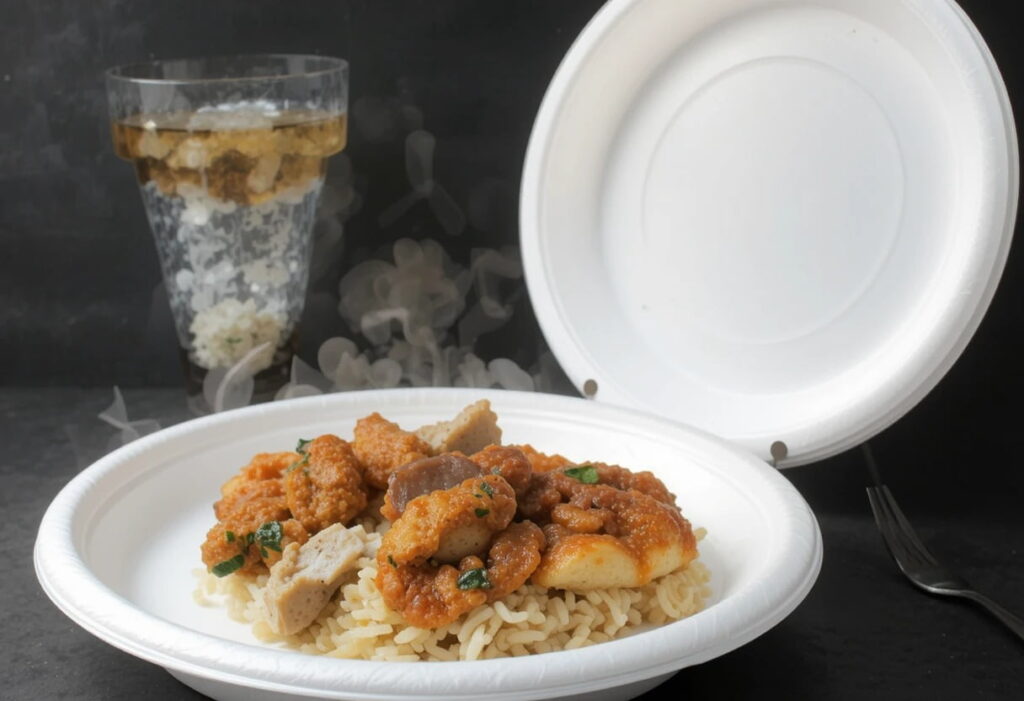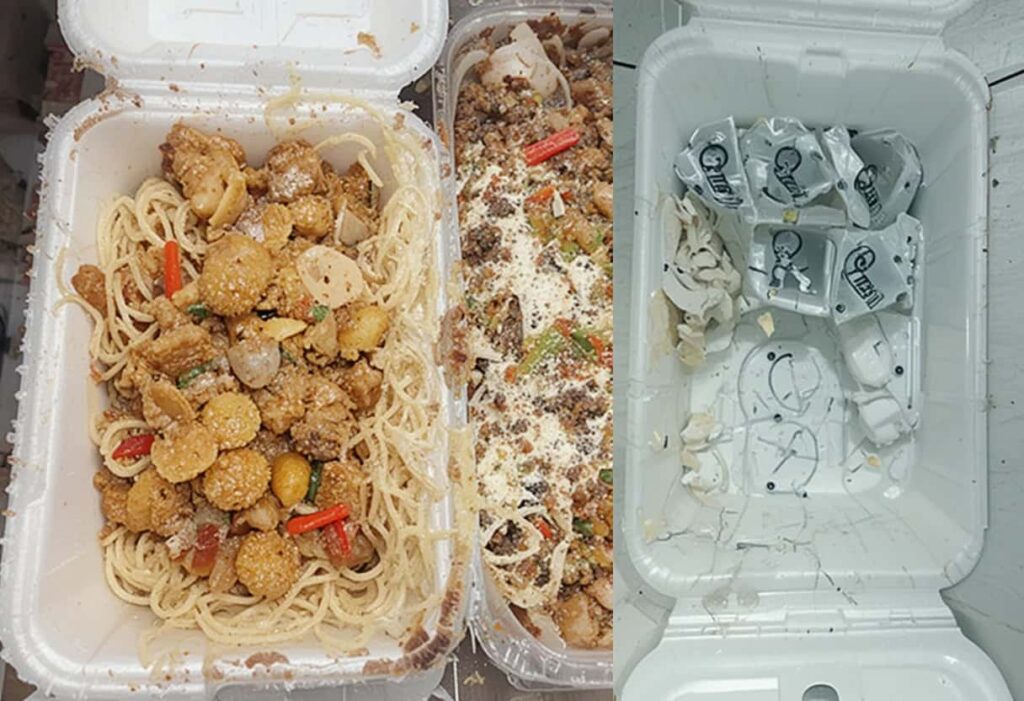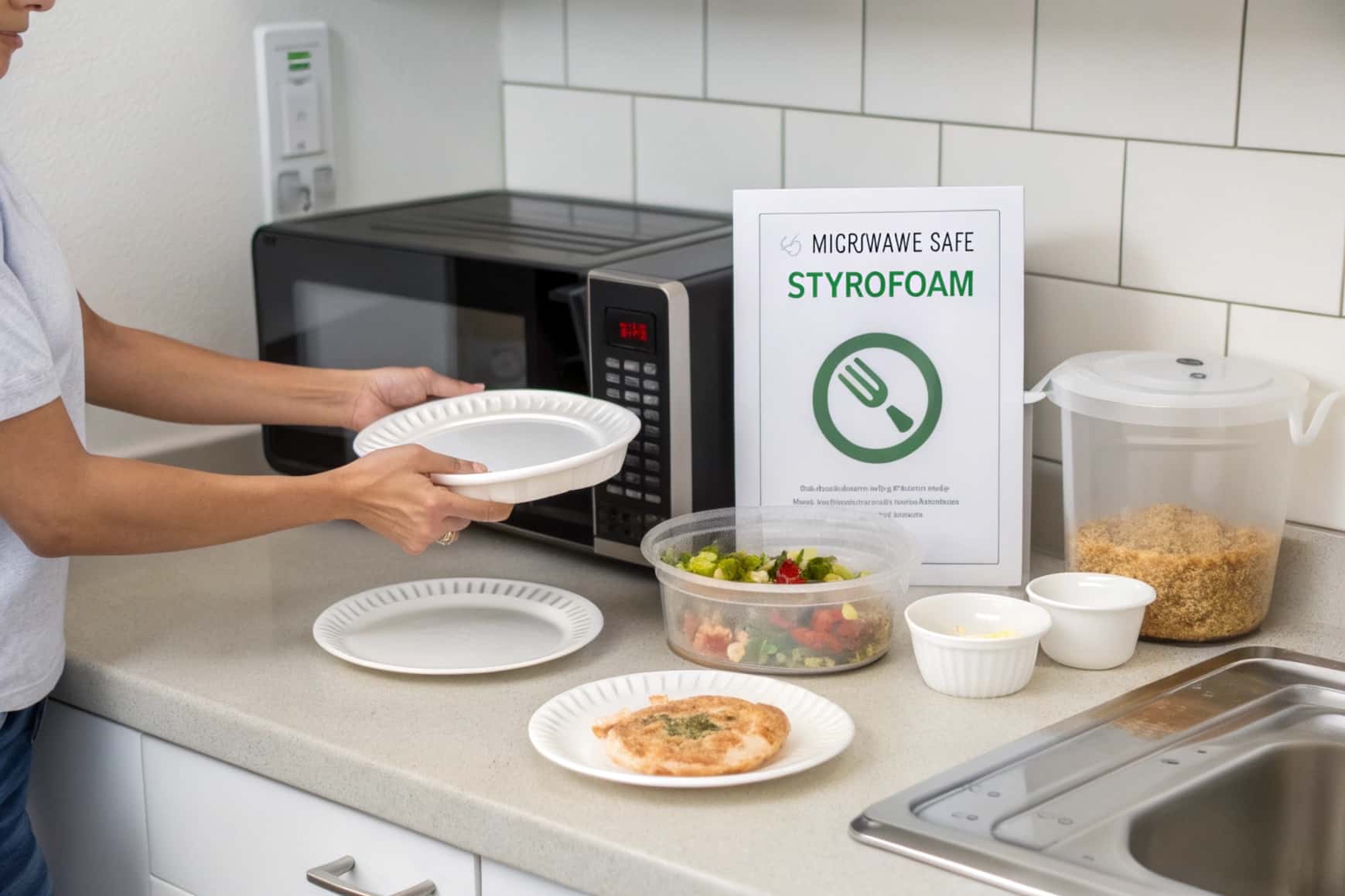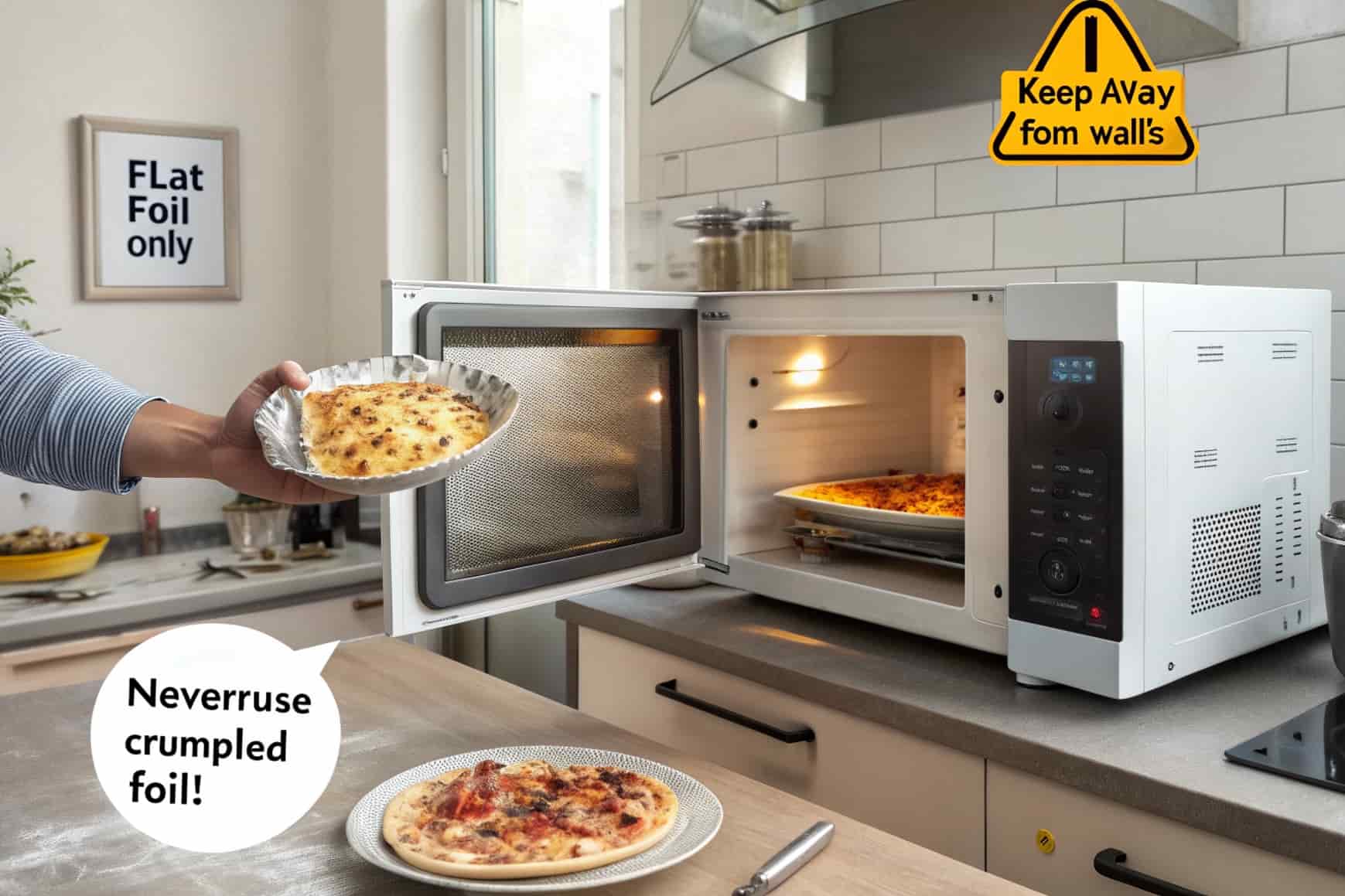I still remember the first time I tried to microwave my food in a Styrofoam plate. It seemed like such a convenient idea—leftover food right in the same container, straight into the microwave for a quick heat-up. But what happened next made me realize how important it is to understand whether Styrofoam plates are safe to use in the microwave.
Many people, just like I did, assume it’s fine to heat food in these plates. That moment made me start thinking seriously about the safety of what we use to reheat our meals. In this article, I will share my personal experience, talk about what Styrofoam is, how it reacts in the microwave, and the best ways to stay safe while reheating food.
What Are Styrofoam Plates?

Before jumping into microwaving, let’s clear up what Styrofoam really is. The term “Styrofoam” is actually a brand name owned by Dow Chemical for a specific type of foam used mainly in building insulation called extruded polystyrene foam.
The disposable foam plates and takeout containers that most people call Styrofoam are actually made from expanded polystyrene foam (EPS). This material is mostly air—about 95%—which is why it’s so light but still sturdy enough to hold food. These plates are cheap, convenient, and widely used for parties, takeout meals, and outdoor events.
My First Experience Microwaving Styrofoam Plates:
It was a regular weeknight, and I had some leftover pasta from dinner stored in a Styrofoam plate. Without thinking twice, I popped the plate into the microwave to reheat it. Within seconds, I noticed a strange smell and saw the edges of the plate start to soften and slightly warp.
I immediately stopped the microwave and pulled the plate out carefully. That’s when I started researching whether microwaving Styrofoam plates was safe or not—and honestly, it wasn’t what I hoped to hear.
Are Styrofoam Plates Safe to Microwave?
The short answer is: Usually, no. Most Styrofoam plates are not microwave-safe.
Why?
- Chemical Leaching: When heated, the polystyrene in Styrofoam plates can break down and release chemicals such as styrene into your food. Styrene is considered a possible carcinogen, which means it might increase the risk of cancer if consumed regularly.
- Melting and Warping: Styrofoam plates aren’t designed to handle high heat. Microwaving them can cause them to soften, warp, or even melt, which not only ruins the plate but also creates a mess in your microwave.
- Fire Hazard: If microwaved for too long or at too high power, Styrofoam can catch fire or produce harmful fumes.
Because of these risks, health and safety agencies like the FDA (Food and Drug Administration) recommend avoiding microwaving Styrofoam unless it specifically says microwave-safe on the packaging.
How to Know If Your Styrofoam Plate Is Microwave-Safe?
Always check the bottom or side of the plate for a microwave-safe symbol. This usually looks like a small microwave icon with wavy lines. If you see this symbol, it means the manufacturer has tested the product and approved it for microwave use.
If there’s no microwave-safe label, it’s safer not to microwave the plate. Heating it could cause the material to melt or warp, releasing harmful chemicals into your food. These chemicals, like styrene, are linked to health concerns when exposed to high heat. It’s always better to transfer your food to a glass or ceramic dish before reheating. Safety should always come first, even when it feels like just a quick lunch.
What Happened When I Tried Ignoring the Warning?
Once, during a busy day, I microwaved a Styrofoam plate without checking the label. The plate got soft and warped, and I noticed the food tasted a little off. Later, I found out that heating fatty or oily foods in Styrofoam increases the chance of chemicals leaching into your meal.
Since then, I always transfer leftovers into glass or ceramic containers before heating. The smell from that experience stayed in the microwave for hours, which made me feel uneasy. It wasn’t just about taste anymore—it was about health and long-term safety. That one small mistake made me rethink how I use kitchen items. Taking a few extra seconds to switch containers now feels like a smart habit, not an inconvenience.
What Are Better Alternatives for Microwaving?
If you want to avoid the risks linked to heating food in Styrofoam, here are some safer and more practical alternatives:
- Glass containers: These are one of the safest and most reliable options for microwaving. Glass doesn’t release any chemicals, can handle high temperatures, and allows you to see your food while it’s heating. Brands like Pyrex and Anchor Hocking are trusted for daily use. They’re also dishwasher-safe and last for years, making them a smart kitchen investment.
- Ceramic plates and bowls: As long as they’re free of metallic paint or gold/silver edging, ceramic dishes are microwave-safe. They’re perfect for reheating meals evenly. Ceramic holds heat well, so food stays warmer for longer. Many everyday dishes in homes are already ceramic, making them a convenient and safe option.
- Microwave-safe plastic containers: These are designed to withstand heat without melting or releasing harmful substances like BPA. Make sure to check for a “microwave-safe” label. They’re lightweight and easy to carry, making them great for lunches or meal prep. However, they may stain with oily or tomato-based foods over time.
- Silicone containers and lids: Silicone is naturally heat-resistant and does not melt or warp in the microwave. It’s flexible, reusable, and doesn’t leach any harmful substances into food. It’s ideal for steaming vegetables, heating baby food, or covering bowls to avoid splatters in the microwave.
- Plain paper plates: If you’re in a hurry, uncoated and microwave-safe paper plates are an okay choice for warming up dry or low-fat foods. Avoid those with plastic or wax coatings, as these can melt or burn. They’re good for single-use situations like snacks or small meals, but not for liquids or greasy foods.
By using these alternatives, you protect both your health and your microwave. It’s a small step that can make a big difference in your daily routine.
Alternatives to Microwaving Styrofoam Plates:
If you’re concerned about microwaving Styrofoam, consider these safer options:
Glass Containers:
Heat-resistant glass won’t leach chemicals or warp. Ideal for liquids and messy foods. Look for tempered varieties with microwave-safe labels. Transparent walls let you monitor reheating. Oven-to-fridge versatility makes them perfect for meal prep. Hand wash or dishwasher safe for easy cleaning.
Ceramic Dishes:
High-fired ceramics distribute heat evenly without hot spots. Ensure glazes are lead-free and microwave-approved. Avoid metallic trim that can spark. Thicker designs prevent cracking. Versatile for serving and reheating. Retains warmth longer than plastic. Chip-resistant options last for years.
Silicone Lids & Covers:
Flexible food-grade silicone withstands extreme temperatures. Creates steam vents while containing splatters. Stretchable design fits various bowl sizes. Non-porous surface resists stains and odors. Collapsible models save storage space. Dishwasher safe for effortless cleaning. Replaces single-use plastic wrap.
Plain Paper Plates:
Unbleached, wax-free paper plates work for short reheating. Avoid printed designs with potential toxins. Best for dry foods under 2 minutes. Compostable varieties reduce waste. Not suitable for oily or saucy dishes. Always verify microwave-safe certification.
The Health Risks of Heating Styrofoam Plates:
My biggest concern after learning about microwaving Styrofoam was the health risk. The styrene chemical used in making Styrofoam is listed as a possible carcinogen by the International Agency for Research on Cancer (IARC). This means repeated exposure over time may increase cancer risk.
Moreover, other toxic chemicals can also be released during heating, especially if the plate melts or burns.For occasional use, the risk might be low, but it’s always better to be cautious, especially if you microwave food daily.
What About Takeout Styrofoam Containers?

Often, restaurants pack your food in Styrofoam containers that aren’t microwave-safe. I’ve made the mistake of heating takeout in these containers, which caused melting and an unpleasant smell. It was frustrating to clean up, and the food didn’t taste right afterward.
My advice is to always transfer takeout food to microwave-safe dishes before reheating. This simple step prevents damage to your microwave and keeps your food tasting fresh and safe to eat. Over time, I learned that it’s better to be cautious than to risk exposure to harmful chemicals or a ruined meal.
Environmental Impact of Styrofoam Plates:
Beyond the health concerns associated with using Styrofoam plates, it’s important to consider their impact on the environment. Styrofoam is not eco-friendly and poses significant challenges for waste management. It can take more than 500 years to decompose in landfills, contributing to long-term pollution. Additionally, recycling Styrofoam is difficult because only a few specialized facilities accept expanded polystyrene (EPS).
Given these issues, switching to biodegradable and compostable alternatives—such as plates made from bamboo, sugarcane, or other plant-based materials—is a much better choice for reducing environmental harm. These options break down naturally and help lower plastic waste in our communities.
Tips for Using Styrofoam Plates Safely:
Even if your Styrofoam plate is labeled microwave-safe, following these safety guidelines can reduce health risks:
- Check for Microwave-Safe Label: Always look for the microwave-safe icon on the bottom of the plate before using it. If there’s no clear symbol, don’t take a chance. Unmarked plates can release harmful chemicals or even melt, putting your food and microwave at risk.
- Short Heating Times: Use short intervals—around 30 seconds—to reheat food, rather than heating for long periods. This prevents the plate from overheating or softening too much. Stir food in between bursts to ensure even heating without stressing the Styrofoam material or risking chemical exposure.
- Avoid Oily or Fatty Foods: Greasy foods like pizza, fried rice, or burgers can get much hotter than other meals and cause the plate to warp or melt. The oils can also react more with the Styrofoam, making it more likely to release unsafe substances into your meal.
- Single-Use Only: Styrofoam plates are not meant for repeated use or washing. Reusing them—even if they look okay—can break down the material over time. This weakens their structure and increases the chances of melting or leaching chemicals when used in the microwave again.
- Transfer Food if Unsure: When you’re uncertain about a plate’s safety or if it shows signs of damage, it’s better to move your food to a glass or ceramic dish. It’s a small extra step, but it ensures your meal is heated safely without health concerns.
FAQS:
1. Can all Styrofoam plates be safely microwaved?
Not all Styrofoam plates are safe for microwaving. Only those clearly labeled with a microwave-safe symbol have been tested and approved. Using other Styrofoam plates can cause melting, warping, or chemical leaching into your food. Always check the label before microwaving to protect your health and avoid damaging your microwave.
2. Why do some Styrofoam plates warp or melt in the microwave?
Styrofoam plates that aren’t microwave-safe can soften, warp, or melt because they aren’t designed to withstand high heat. Foods with high fat or oil content heat unevenly and can get hotter than other foods, causing the plate to degrade. This damage can release harmful chemicals and ruin your food and container.
3. Is it harmful if chemicals from Styrofoam leach into my food?
Yes, heating Styrofoam plates that aren’t microwave-safe can cause chemicals like styrene to leach into your food. Styrene is a potential carcinogen and may pose health risks if consumed repeatedly over time. To minimize exposure, avoid microwaving Styrofoam plates that lack proper microwave-safe certification.
4. Are biodegradable plates a safer alternative to Styrofoam?
Biodegradable plates made from natural materials like bamboo, sugarcane, or cornstarch are safer and more environmentally friendly than Styrofoam. These plates break down quickly, don’t release harmful chemicals when heated, and help reduce plastic pollution. Choosing biodegradable options supports both your health and the planet’s well-being.
5. How can I tell if a Styrofoam plate is microwave-safe?
To check if a Styrofoam plate is microwave-safe, look for a symbol on the bottom or packaging, usually a small microwave icon with wavy lines. This means the manufacturer has tested the product for microwave use. If there’s no symbol, it’s safer to transfer food to a microwave-safe container before heating.
Conclusion:
Microwaving Styrofoam plates is generally unsafe unless the plate clearly states it is microwave-safe. Heating regular Styrofoam can cause it to melt, warp, or release harmful chemicals like styrene, which may affect your health. To avoid risks, always check for microwave-safe labels and prefer using glass, ceramic, or silicone containers for reheating. Choosing safer alternatives not only protects your health but also helps keep your microwave clean and prevents environmental harm caused by Styrofoam waste.
Related post:



